
The Hangman's Bridge, the Hangman's Tower and the wine warehouse, located in the historical center of Nuremberg, are among the main attractions and the most romantic ensemble of the city.
In fact, the architectural ensemble creates trio, and six historic structures, consisting ofhalf-timbered buildings of the former wine warehouse (Weinstadel), square water tower (Wasserturm), dvuhjarusnaja the connecting bridge (Pesnicky bridge / Pegnitzüberbrückung), rounded wall of the tower of the Executioner (Henkerturm), the small house of the hangman (Executioner house) and the pedestrian bridge Executioner (Henkersteg).
This "magnificent six" is a single, one of the most famous, photographed and, without a doubt, impressive and unforgettable architectural ensemble of Nuremberg, which is included in the city guides, as well as part of the tourist route "Historical Mile of Nuremberg" (Historische Meile Nürnberg).
In the photo from left to right - a wine warehouse, a water tower, a connecting bridge and an Executioner's tower
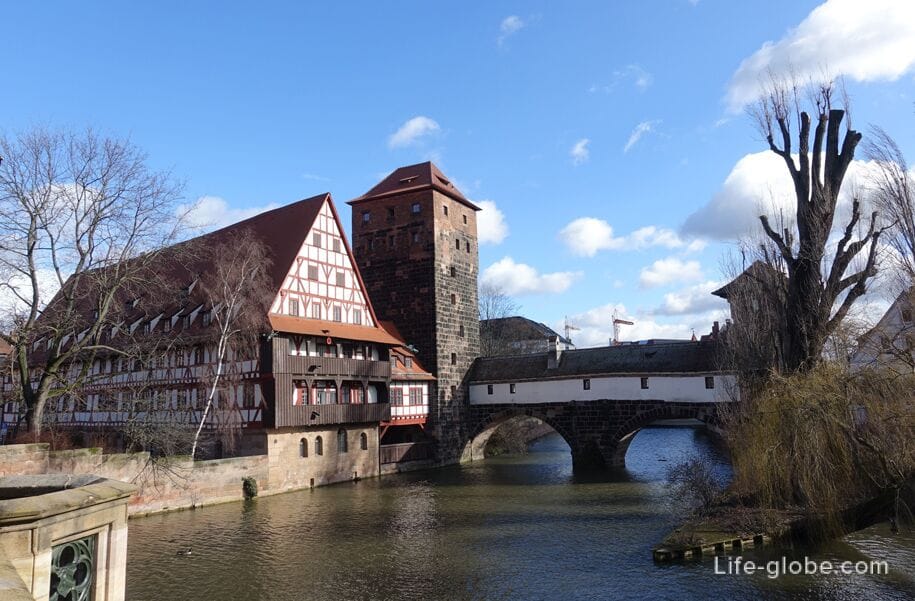
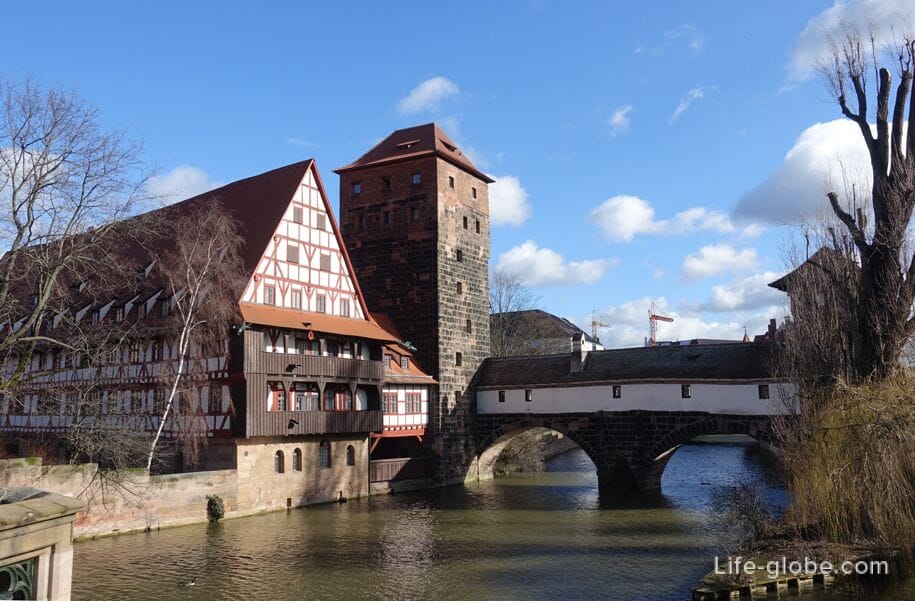
In the photo from left to right - the Hangman's Tower and the Hangman's Bridge

The Hangman's Bridge, also known as the Hangman's Walk Bridge (Henkersteg /Henkersteg, Henkerbrücke / Henkerbrücke) is a wooden pedestrian covered bridge over the Pegnitz River.
The bridge was first built in 1457 on the penultimate city fortifications. In 1595, the bridge was washed away by a severe flood. After that, the bridge was rebuilt with an extension to the south.
During the Second World War, the bridge was damaged and reconstructed in 1954.
The bridge got its name "Hangman's Bridge", which literally translates from German as "The Way to the Executioner", because of the nearby Hangman's Tower - the former residence of the executioners of the imperial city.
Today, the Hangman's Bridge is still pedestrian. It has a wooden structure with a sloping roof. It starts at the Hangman's Tower on the island "Flea Market" (Trödelmarkt) and leads in a southerly direction to the Unschlittplatz square (Unschlittplatz) and the "Fat House" (Unschlitthaus).
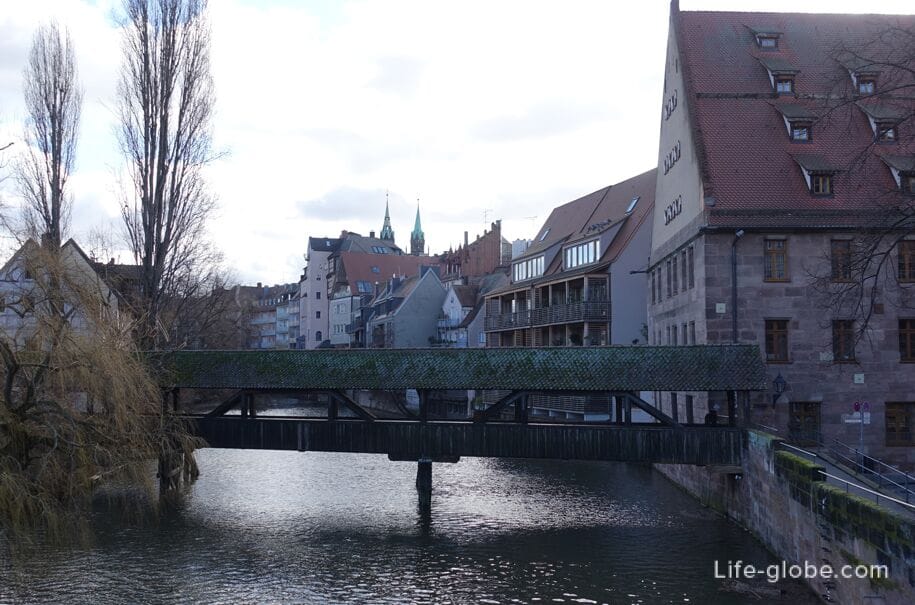


In the photo, the Executioner's Bridge is on the left, the Fat House is on the left, just behind the bridge

The Hangman's Tower (Henkerturm) is a wall tower built in 1320-1323 as part of a connecting bridge over the Pegnitz River in the west of the penultimate city fortifications of Nuremberg.
Initially, the tower protected the outflow of the river and lost its function in 1400, when the last city fortifications were built.
The executioners of the city then used the built-up bridge over the Pegnitz arm, which could be accessed through the Executioner's tower, as a hidden passage to the city and as rooms for living.
In the Middle Ages, city executioners were disrespected. The executioner had to live outside the city limits and got into the city with the help of a closed bridge. This bridge is also called the Executioner's Bridge.
The Hangman's Tower is located on the western bow of the "Flea Island". It has a rounded convex structure on the western side, whereas on the southern side it is square.
Directly adjacent to the tower, on its northern side, is a two-arched lancet connecting bridge made of sandstone with an overbuilt half-timbered roof and a gable roof. This bridge is also known as the "Pegnitz Bridge" (Pegnitzüberbrückung).
View of the Hangman's Tower

View of the connecting bridge
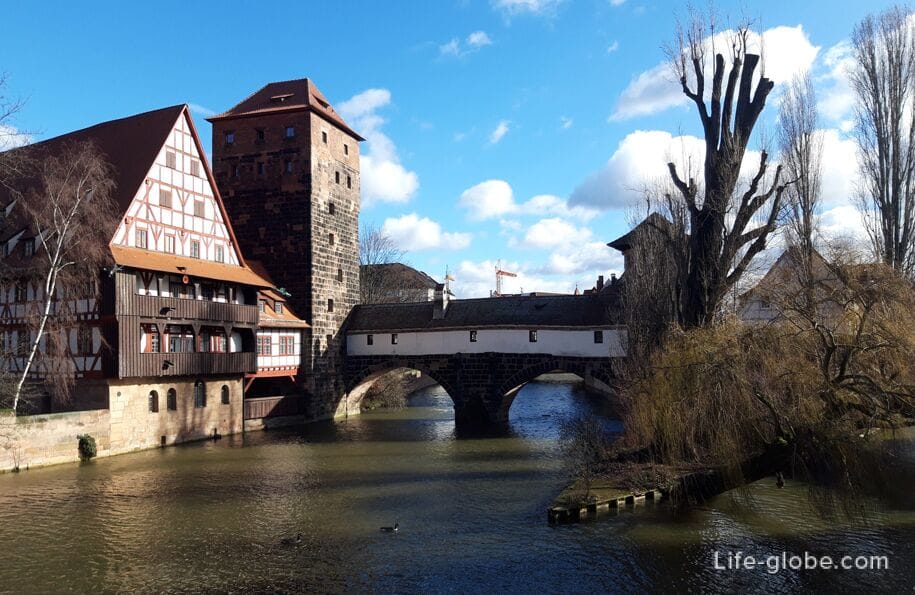
On the east side, the Executioner's Tower (the entrance from Flea Island) is adjacent to the so-called Executioner's house (Executioner house).
Red and white Franconian shutters stand out in the exterior of this small house.
In 2007, a small museum of the criminal history of Nuremberg (Henkerhaus museum) was opened in the executioners' rooms, which is illustrated by the example of the diary of the city's most famous executioner, Franz Schmidt (circa 1600).
The hangman's house is clearly visible from the eastern side of the ensemble - from the Flea Market Island itself or from the northern embankment.
The address of the hangman's house: Trodelmarkt 58.
In the photo from left to right - the Hangman's house and tower, the connecting bridge and the water tower

The square water tower (Wasserturm) was erected in 1320-1323 in part of the penultimate Nuremberg city fortifications.
The lower floors of the tower were built of stone blocks, the upper two - of brick. The tower has small windows and a pitched roof.
Initially, the tower protected the outflow of the river. It lost its function after the construction of the last city fortifications from 1400 and was then used as a prison.
Since the building was only used during Holy Week, the nuns from Pillenreuth found refuge here during the war (for example, during the Margrave wars).
Over time, the building housed artisans, poor families, a women's spinning house and hospital facilities.
Around 1571, the first floor served as the wine shop of the imperial city. The name of the building came from the store.
Today the building is the largest half-timbered structure in Germany. It has a length of 48 meters. Above the sandstone basement there are two half-timbered upper floors. The upper part of the building is crowned by a three-story gable roof. By the waters of the Pegnitz River, the building is equipped with wooden galleries (balconies) with decorative metal gargoyles.
The wine warehouse and the water tower are structurally connected by a small structure with a gable roof.
The premises of the tower and the former warehouse have been modernized and since 1950 have been used as a student dormitory of the University of Erlangen-Nuremberg (Studentenwerk Erlangen-Nuremberg).
Coordinates of the water tower and wine warehouse: 49.45357800, 11.07329600.
In the photo, the wine warehouse is on the left, behind it is a water tower. View from Maximilian's Mota (Maxbrücke)
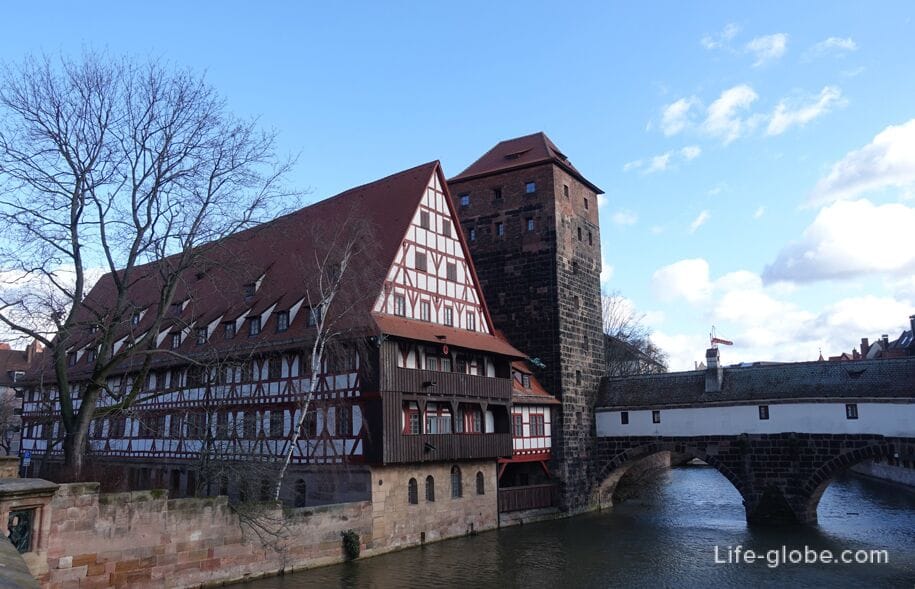
View of the western and northern facades of the wine warehouse from Maxplatz square
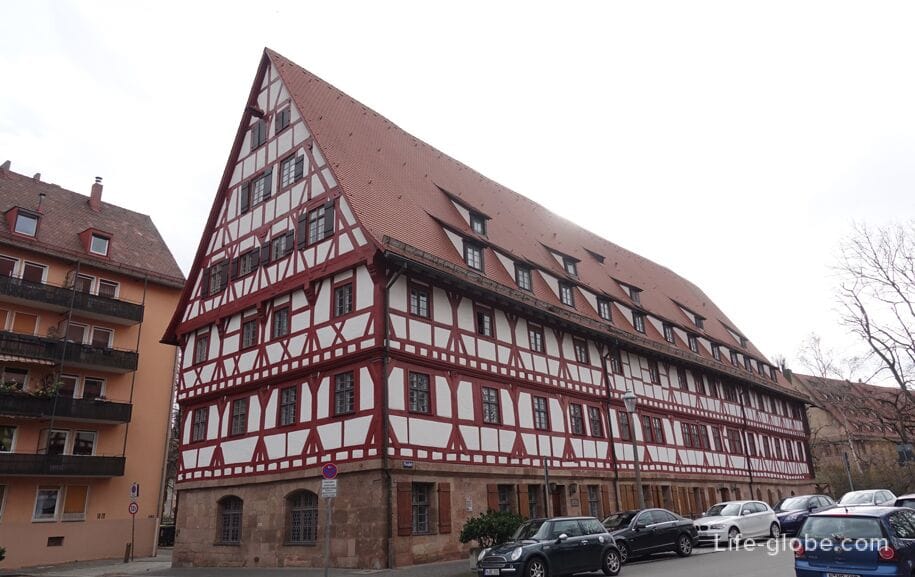
View of the eastern facade of the wine warehouse and the water tower
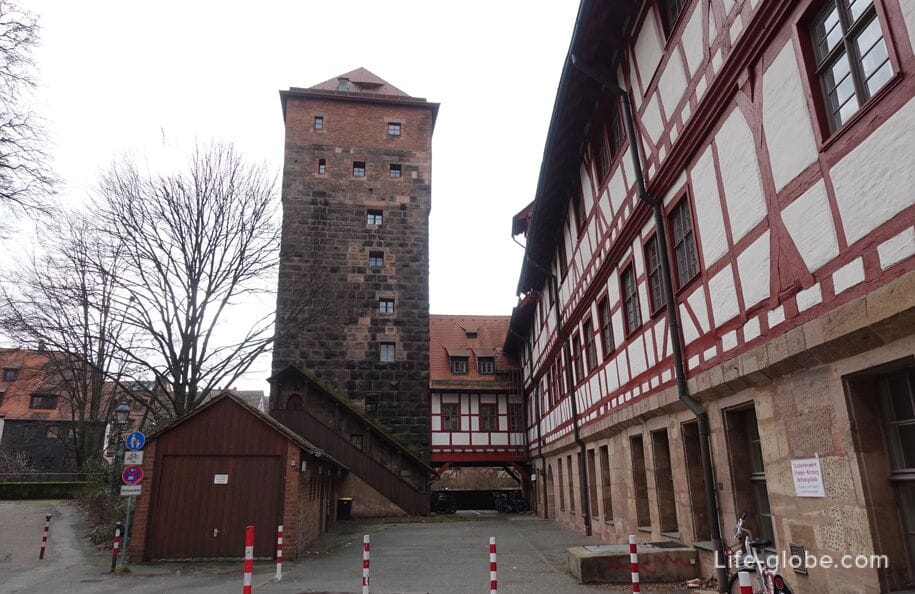
Near the Hangman's Bridge and the surrounding attractions, you can stop:
The 3-star Hauser Boutique Hotel offers a restaurant, free Wi-Fi, parking and room service.
The rooms are equipped with a flat-screen TV, a minibar and a private bathroom. Link to the hotel
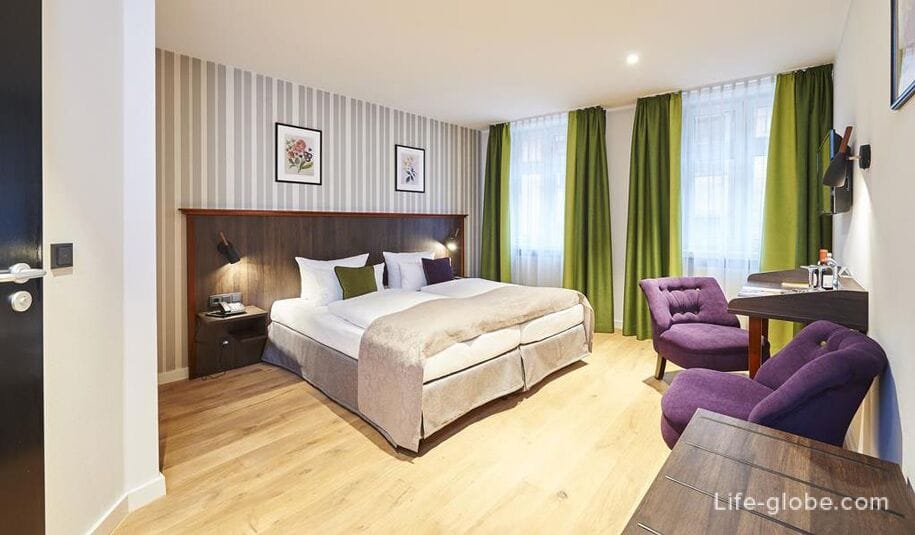
The Nuremberg Holidays Studio Apartment complex offers free Wi-Fi throughout, private parking and family rooms.
All rooms/apartments are equipped with a flat-screen TV. There is also a kitchenette, equipped with a microwave, toaster, refrigerator, stove, coffee machine and kettle. The private bathroom comes with a shower and a hairdryer. Link to the complex
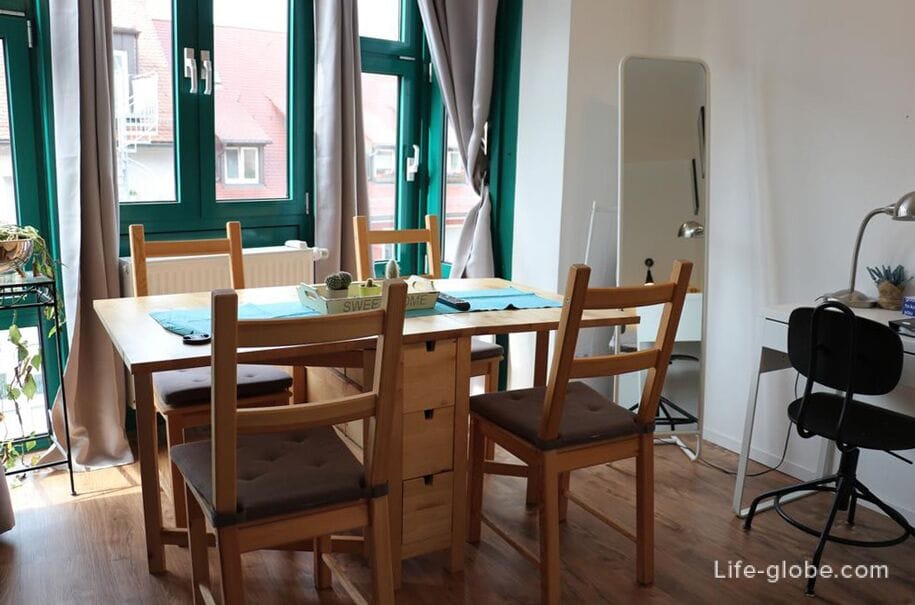
Central Hotel offers free Wi-Fi, parking, heating, elevator and buffet breakfast.
The rooms are equipped with a flat-screen TV and a free bottle of mineral water upon arrival. Link to the hotel
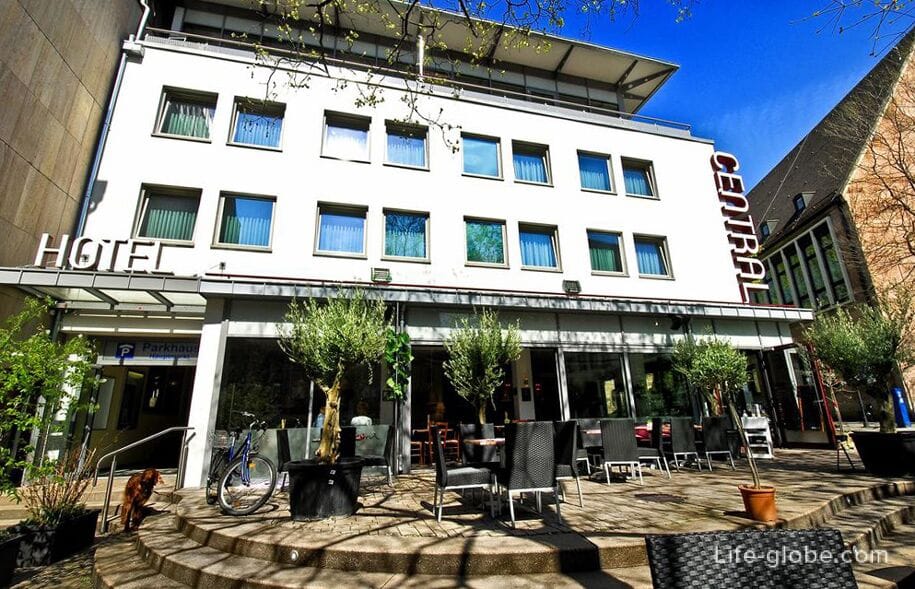
All accommodation facilities in Nuremberg, including in the city center and near the architectural ensemble, can be viewed and booked here